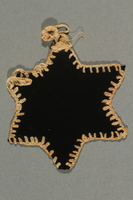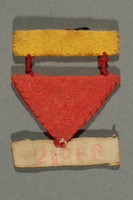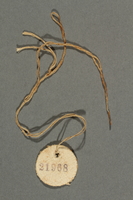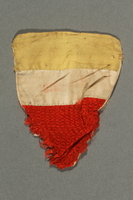Overview
- Description
- The papers consist of documents and photographs relating to the experiences of Charlotte (Lotte) Zagorska during the Holocaust, when she was imprisoned in Wolta-Gabersdorf forced labor camp, and after the war.
- Credit Line
- United States Holocaust Memorial Museum Collection, Gift of Deborah Pogel
Physical Details
- Genre/Form
- Photographs.
- Extent
-
1 folder
Rights & Restrictions
- Conditions on Access
- There are no known restrictions on access to this material.
- Conditions on Use
- The Museum is in the process of determining the possible use restrictions that may apply to material(s) in this collection.
Administrative Notes
- Holder of Originals
-
United States Holocaust Memorial Museum
- Legal Status
- Permanent Collection
- Provenance
- Donated to the United States Holocaust Memorial Museum in 2017 by Deborah Pogel, daughter-in-law of Charlotte Pogel.
- Record last modified:
- 2023-02-24 14:30:54
- This page:
- https://collections.ushmm.org/search/catalog/irn561541
Download & Licensing
- Copyright Not Evaluated
- Terms of Use
- This record is not digitized and cannot be downloaded online.
In-Person Research
- Request 7 Days in Advance of Visit
- Plan a Research Visit
-
Request in Shapell Center Reading Room
Bowie, MD
Contact Us
Also in Charlotte Zagorska Pogel collection
The collection consists of prisoner badges, a Star of David patch, documents, and photographs relating to the experiences of Charlotte (Lotte) Zagorska during the Holocaust in German occupied Poland when she was imprisoned in Wolta-Gabersdorf forced labor camp, and after the war.
Date: approximately 1940-approximately 1950

Black plastic Star of David badge worn by a German Jewish forced laborer
Object
Black plastic Star of David badge worn by Lotte Zagorska (later Charlotte Pogel) while interned in Wolta-Gabersdorf forced labor camp in Libeč, Czechoslovakia, from May 1942 to May 1945. The camp was attached to a cotton mill, and Lotte made the badge from the laborers’ work aprons. Lotte’s family was originally from Breslau, Germany, but had been forced to relocate to Katowice, Poland, in October 1938, following “Aryanization” of the company where her father, Leopold, worked. When Germany invaded Poland in September 1939, Lotte lived with her family in Jaworzno. In October, Lotte secretly returned to Breslau while her friend Ada Oschinsky tried to get her a British work permit. In July 1940, Lotte returned to Jaworzno, and learned that her father had been arrested in Berlin. In 1941, her father was released and returned to serve on a forced labor detail. In May 1942, Lotte was transported to Sosnowitz transit camp and then deported to Wolta-Gabersdorf. Lotte worked on the factory floor before being moved into the office to work with her friends Herta and Ruth Michaelis. In March 1944, the factory became a sub-camp of Gross-Rosen Concentration camp. On May 9, 1945, 2 days after Germany’s surrender, Wolta-Gabersdorf was liberated by Soviet forces. Lotte worked in England for 6 months before immigrating to the United States. She later learned that her mother had likely been killed at Auschwitz concentration camp in 1942, and that her father had died in Markstädt forced labor camp in 1944.

Three part badge with number 21968 worn by a German Jewish forced laborer
Object
Removable cloth badge stamped with prisoner number, 21968, worn by Lotte Zagorska (later Charlotte Pogel) while interned in Wolta-Gabersdorf forced labor camp in Libeč, Czechoslovakia, from May 1942 to May 1945. She was issued the number in March 1944, when the camp became a sub-camp of Gross-Rosen Concentration camp. As a worker in a cotton spinning factory, she likely made the badge. Lotte’s family was originally from Breslau, Germany, but had been forced to relocate to Katowice, Poland, in October 1938, following “Aryanization” of the company where her father, Leopold, worked. When Germany invaded Poland in September 1939, Lotte lived with her family in Jaworzno. In October, Lotte secretly returned to Breslau while her friend Ada Oschinsky tried to get her a British work permit. In July 1940, Lotte returned to Jaworzno, and learned that her father had been arrested in Berlin. In 1941, her father was released and returned to serve on a forced labor detail. In May 1942, Lotte was transported to Sosnowitz transit camp and then deported to Wolta-Gabersdorf. Lotte worked on the factory floor before being moved into the office to work with her friends Herta and Ruth Michaelis. On May 9, 1945, 2 days after Germany’s surrender, Wolta-Gabersdorf was liberated by Soviet forces. Lotte worked in England for 6 months before immigrating to the United States. She later learned that her mother had likely been killed at Auschwitz concentration camp in 1942, and that her father had died in Markstädt forced labor camp in 1944.

Circular badge with number 21968 worn by a German Jewish forced laborer
Object
Circular cloth badge stamped with prisoner number 21968, worn by Lotte Zagorska (later Charlotte Pogel) while interned in Wolta-Gabersdorf forced labor camp in Libeč, Czechoslovakia, from May 1942 to May 1945. She was issued the number in March 1944, when the camp became a sub-camp of Gross-Rosen Concentration camp. As a worker in a cotton spinning factory, she likely made the badge. Lotte’s family was originally from Breslau, Germany, but had been forced to relocate to Katowice, Poland, in October 1938, following “Aryanization” of the company where her father, Leopold, worked. When Germany invaded Poland in September 1939, Lotte lived with her family in Jaworzno. In October, Lotte secretly returned to Breslau while her friend Ada Oschinsky tried to get her a British work permit. In July 1940, Lotte returned to Jaworzno, and learned that her father had been arrested in Berlin. In 1941, her father was released and returned to serve on a forced labor detail. In May 1942, Lotte was transported to Sosnowitz transit camp and then deported to Wolta-Gabersdorf. Lotte worked on the factory floor before being moved into the office to work with her friends Herta and Ruth Michaelis. On May 9, 1945, 2 days after Germany’s surrender, Wolta-Gabersdorf was liberated by Soviet forces. Lotte worked in England for 6 months before immigrating to the United States. She later learned that her mother had likely been killed at Auschwitz concentration camp in 1942, and that her father had died in Markstädt forced labor camp in 1944.

Triangular, tri-color badge with number 21968 worn by a German Jewish forced laborer
Object
Triangular, tri-color, cloth badge stamped with prisoner number, 21968, worn by Lotte Zagorska (later Charlotte Pogel) while interned in Wolta-Gabersdorf forced labor camp in Libeč, Czechoslovakia, from May 1942 to May 1945. She was issued the number in March 1944, when the camp became a sub-camp of Gross-Rosen Concentration camp. As a worker in a cotton spinning factory, she likely made the badge. Lotte’s family was originally from Breslau, Germany, but had been forced to relocate to Katowice, Poland, in October 1938, following “Aryanization” of the company where her father, Leopold, worked. When Germany invaded Poland in September 1939, Lotte lived with her family in Jaworzno. In October, Lotte secretly returned to Breslau while her friend Ada Oschinsky tried to get her a British work permit. In July 1940, Lotte returned to Jaworzno, and learned that her father had been arrested in Berlin. In 1941, her father was released and returned to serve on a forced labor detail. In May 1942, Lotte was transported to Sosnowitz transit camp and then deported to Wolta-Gabersdorf. Lotte worked on the factory floor before being moved into the office to work with her friends Herta and Ruth Michaelis. On May 9, 1945, 2 days after Germany’s surrender, Wolta-Gabersdorf was liberated by Soviet forces. Lotte worked in England for 6 months before immigrating to the United States. She later learned that her mother had likely been killed at Auschwitz concentration camp in 1942, and that her father had died in Markstädt forced labor camp in 1944.



